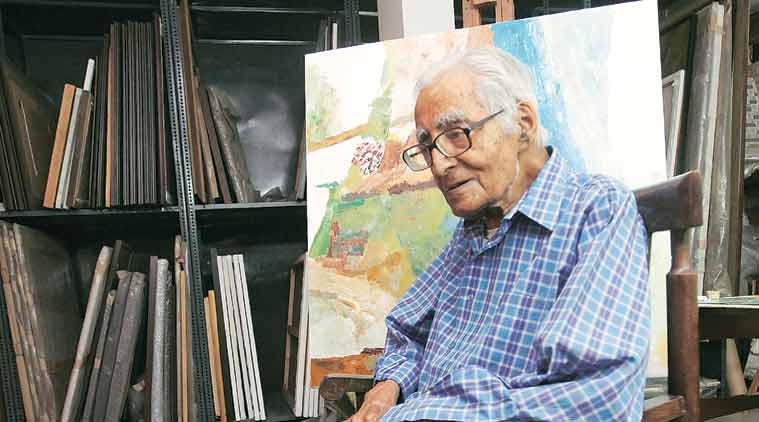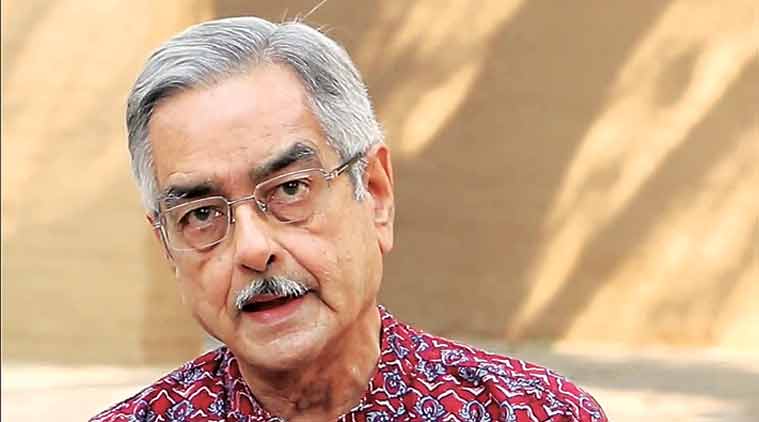 Ram Kumar was born on 1924 and passed away in 2018. (Amit Mehra)
Ram Kumar was born on 1924 and passed away in 2018. (Amit Mehra)
(Written by Prayag Shukla)
I first met Ram Kumar in Kolkata in 1962. He was then better-known as an important short story writer of Hindi and not so much as a painter. That was to come later. At that time, I had also started writing short stories, and some of them had been published. So before coming to Kolkata, he wrote me a post card that he would like to meet me. I was thrilled that a writer of such a stature wanted to see me. The next meeting was to be in Delhi in 1964. I had come to Delhi with the intention of settling down here, but had not done any prior arrangements to this effect. One day, he offered that I could stay at his studio in Gole Market till I got a room on rent.
 Art critic Prayag Shukla recalls his 55-year-long association with the celebrated artist.
Art critic Prayag Shukla recalls his 55-year-long association with the celebrated artist.
That was the beginning of a very long association with him and the whole family, including his brother Nirmal Verma, a writer par excellence. In Ram Kumar’s studio, I would meet MF Husain, Krishen Khanna, Tyeb Mehta, Nasreen Mohamedi and others. This was also the time when I started meeting J Swaminathan, Ambadas, Jeram Patel, Himmat Shah in coffee houses and galleries, which were few at that time. This is when Ram Kumar encouraged me to start writing on art as well. A freelance writer, I needed financial support.
 (Above) Ram Kumar with MF Husain and others (Courtesy: Aakriti Art Gallery)
(Above) Ram Kumar with MF Husain and others (Courtesy: Aakriti Art Gallery)
Subsequently, I started writing for the Hindi weekly Dharmayug and then in Dinaman, on art. I got immersed in it gradually. I was close to him and a great admirer of his art and short stories, and stayed in his studio for three months. His paintings of the early period, where he portrayed the unemployed youth and certain melancholies of the middle and lower middle classes in urban surroundings, seemed to speak to us in a very intimate manner. When his art transformed itself to abstract, after his visits to Varanasi, that was also quite appealing. It depicted a certain way of looking at life and art. One can’t miss its spiritual and humane intent.
 An untitled work by Ram Kumar, created in 2014. (Courtesy: Vadehra Art Gallery)
An untitled work by Ram Kumar, created in 2014. (Courtesy: Vadehra Art Gallery)
Today is also the day when we should remember Richard Bartholomew, the critic and friend of Ram Kumar, who wrote passionately about his art and persona, allowing generations of art lovers to communicate effortlessly with the celebrated painter’s oeuvre. For one assignment, I interviewed Ram Kumar in 16 sittings. It was the mid ’70s, when shades of red, blue and green started emerging in his works. I commented that with these bright colours, it seems your sad, melancholic period is finally over. To which he quickly replied, “Lal rang bhi udaas ho sakta hai (even red can be melancholic)”. I have never forgotten that observation.
With his palette knife, brushes, pastels, pen, pencil, acrylics and oils, he has created wondrous works on canvas and paper. He used to work daily in his studio till the very last, before he was admitted to Max Hospital a month ago. I have always been enamored with his drawings in black and white, done on bahikhatas (account books), in the early ’60s, and to my great satisfaction with the support of his late wife, Vimalaji, I was able to persuade him to lend us a few for exhibiting, so that they could be viewed by the public.
Finally, these were mounted in four shows in Delhi, Kolkata and Mumbai, which I curated. His drawings are a class in themselves, where lines traverse freely to chart their own course of many moods, emotions, and memorable associations, stored in the memory of the artist. About four days ago, I had gone to see him at the hospital. He was lying on the bed, with his eyes closed. Hearing the sound of my footsteps, he opened his eyes, raised his left hand a bit and then closed his eyes. That was our last meeting, but the long association of more than 55 years is not going to end. His kindness, simplicity and helping nature will continue to inspire us.
(The art critic is a close associate of Ram Kumar, who curated his exhibitions, and wrote extensively on his art and writings)
Brush with the past:
1924: Born in Shimla
1946: Studied Economics at St Stephen’s College in New Delhi
1949-1952: Went to Paris to study painting under French artists Andre Lhote and Fernard Leger
Early 1960s: A journey to Varanasi with MF Husain propelled him to turn to abstract paintings, abandoning figurative paintings, thereby marking a significant departure in his artistic oeuvre
Late 1960s: His landscapes soon changed to abstract interpretations of nature as Kumar rendered it from different angles — where one could spot a storm, an avalanche, forests nestled alongside rivers and towering mountains
1972: He got the Prem Chand Puruskar by the UP government for Meri Pyari Kahaniya, his collection of short stories
Early 1990s: Kumar returned to architecture three decades later as he took to painting tombs inspired by the Lodhi Gardens and Mughal architecture
1993: A major retrospective of his works created between 1949 and 1993 was held at Delhi’s National Gallery of Modern Art
1996: Vadehra Art Gallery presented a solo show on the artist, ‘Ram Kumar: A Journey Within’
2003: He was conferred with the Officers Arts et Letters by France
2008: His painting The Vagabond, which he painted in the 1950s, depicting the homeless in Europe, fetched $1.1 million at Christie’s auction in New York, setting a record price for the artist
2010: Kumar was bestowed with the Padma Bhushan
2011: Aicon Gallery, London, held a retrospective of his works, titled ‘Ram Kumar: A Retrospective’
(Pallavi Chattopadhyay)